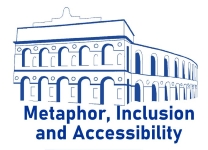|
|
|
Seminar ThemeMetaphor, Inclusion and Accessibility Our understanding of cognitive and physical disabilities, accessibility, and inclusive practices are largely shaped by metaphor. In such contexts, it is almost impossible to avoid reference to barriers and obstacles, i.e. metaphors structured by the image schemata of BLOCKAGE, RESTRAINT-REMOVAL, ENABLEMENT (Johnson 1987), whose removal – via bridges, pathways, and the unlocking of potential – ensures access (informed by the CONTAINER image schema, ibid.). This metaphorical terminology frames access as the provision of entry points to physical spaces, and the retrospective viewpoints expressed in the discourse of retrofitting, tacking-on,and re-designing architectural structures reveals how accommodating different abilities is all too often an afterthought. The epistemological shift in more recent years “from a barrier-centred view to one that is focused on people’s diverse abilities” (Di Giovanni & Raffi 2023: 168) has yet to percolate down into mainstream discourse, and as a result society at large is still playing catch-up. As Goethals et al. (2020) demonstrate, media representations of people with disabilities overwhelmingly perpetuate traditional stereotypes, relying on well-worn tropes such as the PARASITE, the BURDEN, and the VICTIM, which recur in discourses of all sorts of ‘outlier’ societal groups (see e.g. Musolff 2022, Santa Ana 1999, Tipler & Ruscher 2014). Yet such depictions do not reflect the lived experiences of differently-abled people, and do not chime with the current mood in society to reframe divergent cognitive and physical abilities as assets, not defects; as opportunities to improve and redesign services and spaces that are accessible to all. Metaphor studies itself has been accused of ableist bias, since both primary metaphors and embodiment theory base their somewhat universalist claims on the lived experiences of “normally functioning people” (El Refaie 2014: 110; see also Littlemore 2019: 123-137; Gibbs 2017: 163-4). Related to this are the entrenched metaphors and idioms involving disability terms such as blind or cripple, which some feel perpetuate harmful stereotypes and (intentionally or indirectly) stigmatise differently-abled individuals (Vidali 2010). As people with different cognitive and physical abilities find their voice, these discipline-specific areas require refinement and revision to accommodate the diversity of lived human experiences and the conceptual structures that they engender. The seminar theme is compatible with the United Nations Sustainable Development Goals, specifically Goal 10 https://www.un.org/sustainabledevelopment/inequality/
References Di Giovanni, Elena & Francesca Raffi. 2023. Inclusive Theatres as Boosters of Well-Being: Concepts and Practices. Journal of Audiovisual Translation, 5(1): 166-185. https://doi.org/10.47476/jat.v5i1.2022.223 El Refaie, Elisabeth. 2014. Appearances and dis/dys-appearances? A dynamic view of embodiment in conceptual metaphor theory. Metaphor and the Social World, 4(1), 109-125. https://doi.org/10.1075/msw.4.1.08ref Gibbs, Raymond W. Jr. 2017. Metaphor Wars. Conceptual metaphors in human life. Cambridge: Cambridge University Press. https://doi.org/10.1017/9781107762350 Goethals, Tina, Dimitri Mortelmans, Hilde Van den Bulck, Willem Van den Heurck & Geert Van Hove. 2020. ‘I am not your metaphor’: frames and counter-frames in the representation of disability. Disability & Society, 37(5): 746-764. https://doi.org/10.1080/09687599.2020.1836478 Johnson, Mark. 1987. The Body in the Mind. The Bodily Basis of Meaning, Imagination, and Reason. Chicago: Chicago University Press. https://doi.org/10.7208/chicago/9780226177847.001.0001 Littlemore, Jeannette. 2019. Metaphors in the Mind. Sources of Variation in Embodied Metaphor. Cambridge: Cambridge University Press. https://doi.org/10.1017/9781108241441 Musolff, Andreas. 2022. The Scenario of (Im-)Migrants as Scroungers and/or Parasites in British Media Discourses. In: Barbara Schmidt-Haberkamp, Marian Gymnich & Klaus P. Schneider (eds) Representing Poverty and Precarity in a Postcolonial World pp. 246-260. Leiden: Brill. https://doi.org/10.1163/9789004466395_016 Santa Ana, Otto. 1999. ‘Like an Animal I was Treated’: Anti-Immigrant Metaphor in US Public Discourse. Discourse and Society, 10(2): 191-224. https://doi.org/10.1177/0957926599010002004 Tipler, Caroline & Janet B. Ruscher. 2014. Agency’s Role in Dehumanization: Non-Human Metaphors of Out-Groups. Social and Personality Psychology Compass, 8(5): 214-28. https://doi.org/10.1111/spc3.12100 Vidali, Amy. 2010. Seeing What We Know: Disability and Theories of Metaphor. Journal of Literary & Cultural Disability Studies 4(1): 33-54. https://doi.org/10.1353/jlc.0.0032 |


